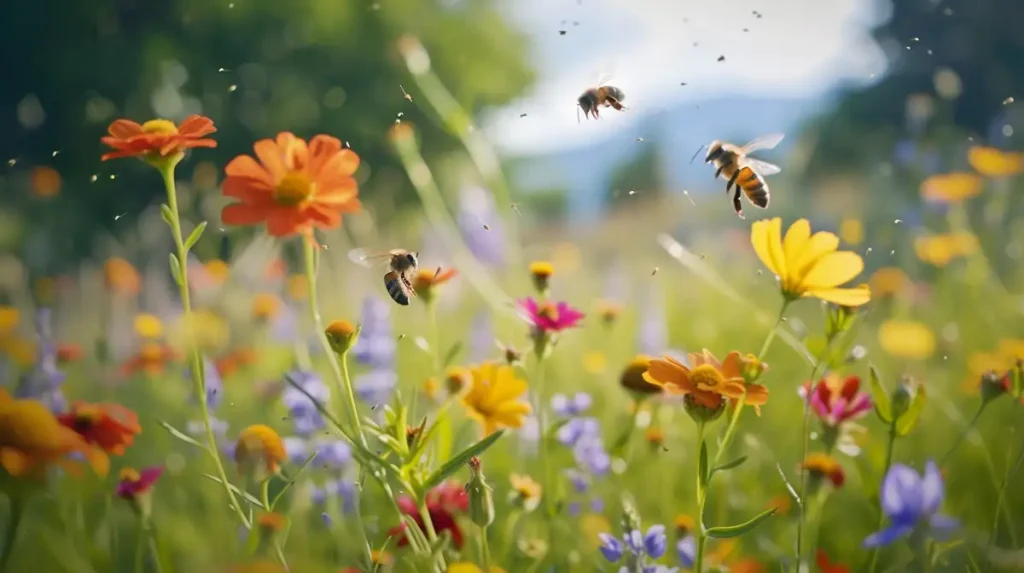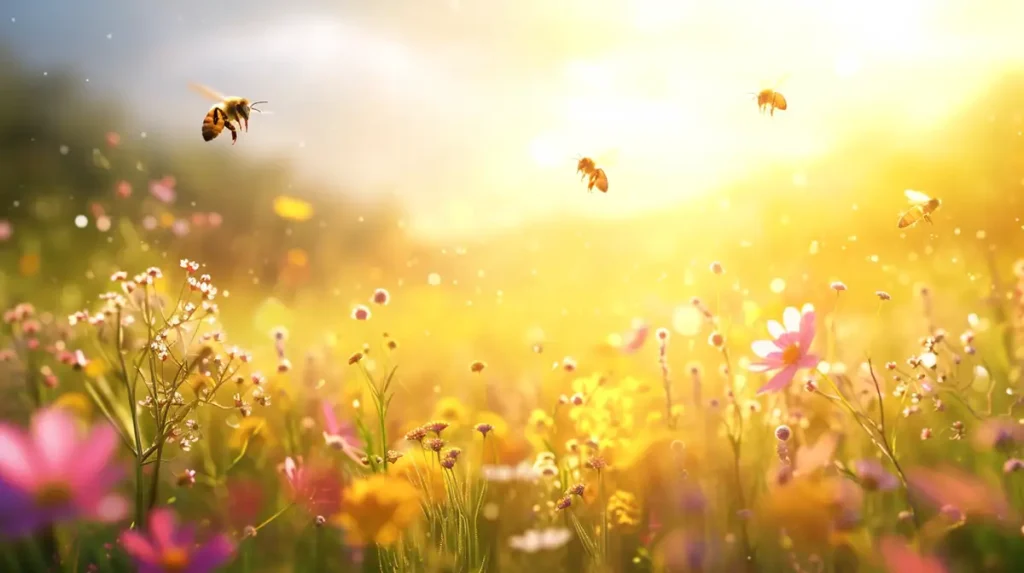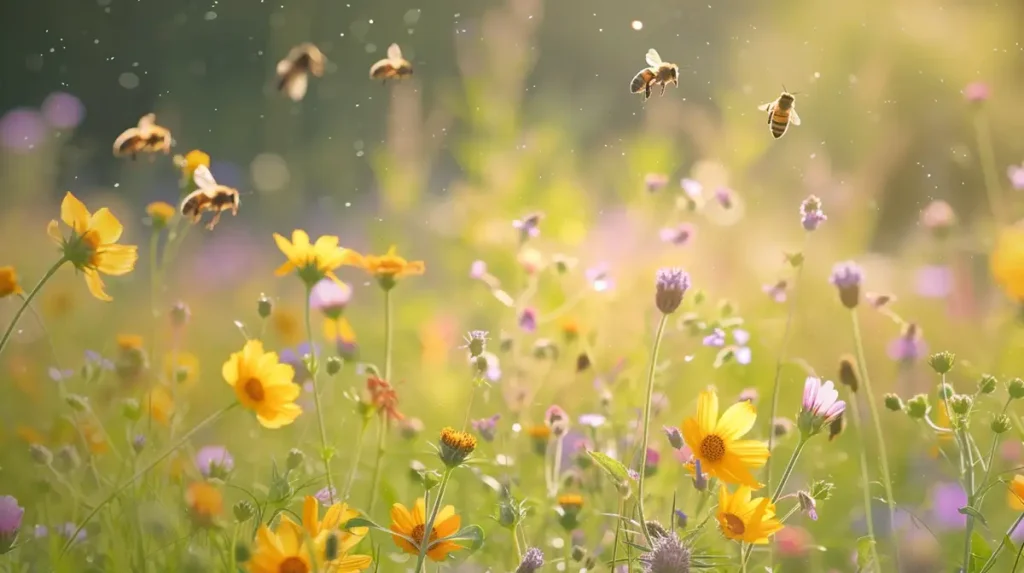Table of Contents
Bees communicate through a combination of dances, pheromones, and vibrations. The most famous is the “waggle dance,” used by forager bees to inform hive mates about the direction and distance to sources of nectar and pollen. Pheromones are chemical signals for various purposes, including marking paths, identifying colony members, and signaling distress. Vibrations or “piping” can also convey messages, such as during the swarming process or to initiate foraging.
In the below paragraphs, we will take a more detailed look at this topic.
When it comes to colonies of bees, teamwork is key to their survival. But how do bees communicate with each other? How do they let each other know if there is a threat to the hive or where the best place to forage can be found?
Key Takeaways
- Bees communicate primarily through the waggle dance to share information about food sources, conveying direction and distance through the movements and duration of the dance.
- Other communication mechanisms include scent (Nasonov pheromone) and taste (regurgitating nectar samples).
- Pheromones play a critical role in bee communication for maintaining colony cohesion, attracting mates, and regulating worker behavior.
- Queen, worker, and drone bees produce different types of pheromones to facilitate communication within the colony.
- Environmental factors, hive health, food availability, and pheromone levels can all influence bee communication.
- Human activities, such as pesticide use, habitat loss, electromagnetic pollution, and noise pollution, can negatively affect bee communication.
- Bee communication has evolved over time, from simple chemical cues like pheromones to the complex waggle dance and the development of advanced visual capabilities and learning abilities.
Here is a detailed table outlining the various methods by which bees communicate:
| Communication Method | Description | Purpose/Function |
|---|---|---|
| Waggle Dance | A figure-eight dance performed by a forager bee on the hive’s comb. The angle and duration of the waggle phase convey information about the direction and distance of a food source. | To inform hive mates about the location of nectar, pollen, water sources, or new nesting sites. The angle relative to the sun indicates direction, and the duration indicates distance. |
| Round Dance | A circular dance performed by a forager bee when a food source is very close to the hive (typically within 50-100 meters). | To indicate a nearby source of food without specifying direction. It motivates other bees to search the area close to the hive for food. |
| Piping | A vibrational sound made by some bees, often queens or worker bees, by moving their wing muscles while not flying. | Used for various purposes, including queen communication during swarming or before emergence, and by worker bees to initiate foraging. |
| Tremble Dance | A dance that involves rapid, vibrating movements performed by forager bees. | To recruit receiver bees to help unload nectar from foragers, particularly when foraging bees are returning faster than the nectar can be processed. |
| Shaking Signal | A bee grabs another bee with its legs and shakes it. | This can be a signal to increase foraging activity or possibly to prepare for swarming. It’s also used by worker bees to awaken other bees for various tasks. |
| Stop Signal | A short vibrational signal given by a bee to another bee, often accompanied by a head butt. | To inhibit the recruitment of foragers to less profitable or dangerous food sources, or to reduce the number of foragers leaving the hive when necessary. |
| Scent Marking | Bees release pheromones from their Nasonov gland or other glandular sources. | To mark paths to food sources, identify the hive entrance, signal alarm, indicate queen presence, or help in swarming by marking a new nest site. |
| Antennation | Bees touch each other with their antennae. | For direct communication and exchange of information, such as food solicitation, recognition between colony members, and assessment of the queen’s reproductive status. |
| Wing Beats and Buzzing | Bees produce sounds through their wing movements, which can vary in frequency and intensity. | May be used to alert other bees, particularly in defense of the hive or to communicate about food sources. The specific meanings of different sounds are less well understood compared to other forms of bee communication. |
| Heat Production | Bees can generate heat by vibrating their flight muscles without actually flying. | Used to regulate the temperature of the hive, particularly for brood rearing, and possibly as a form of communication regarding the need for temperature regulation within the hive. |
This table encapsulates the complex and multifaceted communication strategies employed by bees, showcasing their ability to convey detailed information about food sources, hive status, and environmental conditions to their colony members.
How Do Bees Share Information About Food Sources?
Bees are remarkable creatures, known for their ability to communicate with each other to share information about food sources. The primary method by which bees relay this information to their hive-mates is through the waggle dance.
The Waggle Dance
The waggle dance is a unique and intricate series of movements that a forager bee performs after returning to the hive from a fruitful food source. It comprises a figure-eight pattern consisting of a straight run, followed by a turn to the right or left, and then another straight run. The direction and duration of the waggle dance convey critical information to the other bees.
- Direction: The angle between the straight run of the waggle dance and an imaginary vertical line represents the angle relative to the sun that the food source is located. For example, if the bee moves at a 90-degree angle to the right of the vertical line, the food source is to the right of the sun.
- Distance: The duration of the straight run in the dance correlates to the distance to the food source. A longer waggle run signifies a farther food source, while a shorter one indicates a closer destination.
Other Communication Mechanisms
Besides the waggle dance, bees employ other ways of sharing information about food sources:
- Scent: When a forager bee finds an abundant food source it may also release a pheromone known as Nasonov to attract other bees. This scent is particularly useful when the food source is close to the hive as it provides a stronger signal than the waggle dance alone.
- Taste: Upon returning to the hive, a forager bee may regurgitate a small sample of the nectar it has collected for other bees to taste. This allows the hive to assess the quality of the food source.

What Is The Role Of Pheromones In Bee Communication?
Pheromones play a crucial role in bee communication, enabling the social organization and coordination of activities within a colony. These chemical signals are secreted by different members of the hive, including the queen, workers, and drones, to convey specific messages and maintain the harmony and functionality of the hive.
Queen Pheromones
The queen bee produces a complex set of pheromones known as the queen mandibular pheromone (QMP), which is vital for the colony’s stability. QMP serves multiple purposes:
- Colony cohesion: The queen pheromone helps in maintaining the unity of the colony by preventing workers from producing their own eggs and suppressing the rearing of new queens.
- Mate attraction: Queen pheromones also attract drones during mating flights, ensuring the queen mates with a diverse range of drones for genetic diversity.
- Worker behavior regulation: QMP influences the behavior of worker bees, promoting foraging, brood rearing, and overall hive maintenance.
Worker Pheromones
Worker bees also produce various pheromones that aid in communication within the colony:
- Alarm pheromone: When a worker bee senses danger or an intruder, it releases an alarm pheromone to alert the colony. This pheromone triggers a defensive response, mobilizing the worker bees to protect the hive.
- Nasonov pheromone: This pheromone is produced by worker bees to guide their fellow foragers back to the colony. It is particularly crucial when a swarm finds a new nesting site or during orientation flights for young bees.
- Brood pheromone: Larvae and pupae emit a brood pheromone that communicates their developmental stage and nutritional needs to worker bees. This pheromone helps in coordinating the care and feeding of the brood.
Drone Pheromones
Drones, the male bees in a colony, produce a sex pheromone that attracts the queen during mating flights. This pheromone is crucial for ensuring successful mating and the continuation of the colony’s genetic lineage.

What Factors Influence Bee Communication?
Bee communication is a complex and fascinating subject. Several factors can influence the way bees communicate with one another. Understanding these factors can help beekeepers better manage their hives and ensure the health of the bees.
- Carter, Anthony (Author)
- English (Publication Language)
- 194 Pages - 02/28/2024 (Publication Date) - Independently published (Publisher)
Environmental Factors
One of the main factors that influence bee communication is the environment in which they live. Temperature, humidity, and weather conditions can all impact the effectiveness of communication. For example, bees are less likely to forage when it is cold or rainy, which can result in less frequent or less accurate communication about food sources. Similarly, high levels of humidity can impact the pheromones that bees use to communicate, potentially making it more difficult for them to send and receive messages.
Hive Health
The overall health of the hive also plays a role in bee communication. A healthy hive with a strong queen will have efficient communication among worker bees. However, if the hive is struggling with diseases or pests, this can disrupt the usual communication patterns. Bees may be more focused on addressing the immediate threats to the hive, which can hinder their ability to share information about food sources or other important matters.
Food Availability
The availability of food sources in the surrounding area can also impact bee communication. When there is an abundance of flowers and other food sources bees can be more selective about where they forage, and communication about the location of these resources becomes essential. Conversely, when food is scarce bees may not communicate as much about specific food sources, instead focusing on a wider range of areas to search for nourishment.
Pheromone Levels
As discussed previously, pheromones are chemical signals that bees use to communicate with one another. We saw above that the queen, workers, and drones all produce different types of pheromones that help to maintain order within the hive. If the levels of these pheromones are disrupted, it can lead to confusion and reduced communication within the colony. For example, if the queen’s pheromone levels drop, workers may not be able to recognize her presence, which can lead to disorganization and even the creation of a new queen.
Can Human Activities Affect Bee Communication?
Yes, human activities can have significant impacts on bee communication. Bees rely on a complex system of communication methods (as discussed within this article) to share information about food sources, navigation, and colony coordination. However, various human actions can disrupt these essential communication channels, leading to adverse effects on bee colonies and their ability to thrive.
Pesticides and Chemical Exposure
One of the most significant human-induced factors affecting bee communication is the use of pesticides and other chemicals in agriculture. Exposure to neonicotinoids and other pesticides can cause disorientation and impair the bees’ ability to learn and remember, which directly impacts their communication methods. When foraging bees are exposed to these chemicals, they may struggle to relay accurate information about food sources to the rest of the colony. This can lead to reduced foraging efficiency and overall colony health.
Habitat Loss and Fragmentation
Another crucial factor is habitat loss and fragmentation due to urbanization and agricultural expansion. As natural habitats are destroyed or divided, bees can lose access to essential food sources and nesting sites. This reduction in available resources can lead to increased competition between colonies, which may disrupt communication and cooperation between individual bees.
Electromagnetic Pollution
Electromagnetic pollution, particularly from mobile phone towers and other sources of radiofrequency radiation, has been suggested to interfere with bee communication. Research indicates that exposure to electromagnetic fields may disrupt the bees’ ability to navigate and communicate effectively, although the full extent of this impact remains a topic of ongoing study.
Noise Pollution
Noise pollution, particularly from human activities such as transportation and industrial processes, can also affect bee communication. Loud, constant noise can mask the sounds that bees produce during their waggle dance, making it difficult for other bees to interpret the information being shared. This disruption can lead to reduced foraging success and overall colony health.

How Has Bee Communication Evolved Over Time?
Bee communication has undergone an incredible evolution over millions of years. As social insects, bees have developed sophisticated communication methods to survive and thrive in their colonies. The key driving forces behind this evolution have been their need to coordinate their activities, find food sources, and protect their hive.
Early Bee Communication
In the early stages of bee evolution, communication was likely based on simple chemical cues, such as pheromones. To recap, pheromones are chemical substances that bees release to signal various messages to their hive mates. For example, the queen bee produces a unique pheromone that helps maintain her authority and keep the hive organized. Other pheromones are used to signal danger or attract potential mates. Over time, the use of pheromones has become more refined and diverse to cater to the growing complexity of bee social interactions.
The Emergence of the Waggle Dance
One of the most remarkable developments in bee communication is the emergence of the waggle dance, which is mainly seen in honeybees . This dance allows foragers to communicate the location of food sources to their fellow bees. The dance consists of a series of figure-eight patterns, where the angle of the waggle run conveys the direction of the food source relative to the sun, and the duration of the waggle indicates the distance.
The waggle dance is thought to have evolved as a result of the need for honeybees to efficiently locate and exploit food sources in their environment. As honeybees moved from solitary lifestyles to forming colonies, the need for effective communication became paramount in order to maintain the stability and productivity of the hive.
The Role of Vision and Learning
In addition to the waggle dance, bees have also evolved their visual capabilities and learning abilities to enhance their communication. Bees can perceive a wide range of colors, including ultraviolet, which allows them to see and interpret patterns on flowers that are invisible to the human eye. This helps them identify and remember valuable food sources.
Moreover, bees exhibit a remarkable capacity for learning, which plays a crucial role in their ability to adapt to new environments and challenges. This learning ability is particularly evident in their navigation and foraging strategies. For instance, bees can learn and remember specific landmarks to aid in their navigation, and they can associate certain colors and shapes with rewarding food sources.
How Do Bees Communicate – Conclusion
Bees use very sophisticated methods to communicate with one another. Scout bees perform a waggle dance to inform other bees in the hive where a source of food has been found. This allows the other bees to quickly find nectar and pollen.
Worker bees also use pheromones to alert the colony to danger, and the queen bee releases a chemical scent that maintains order within the hive.
FAQs
Q: What is the waggle dance?
A: The waggle dance is a unique form of communication used by bees, particularly honeybees, to relay information about the location of food sources. It involves a series of intricate movements that convey both the distance and direction to the resource.
Q: How do bees use pheromones to communicate?
A: Bees use pheromones, which are chemical signals, to transmit various types of information to their fellow hive members. Pheromones can be released by the queen, workers, or drones and can convey messages related to reproduction, alarm, orientation, or food sources.
Q: What is the role of the queen bee in communication?
A: The queen bee plays a crucial role in hive communication by releasing pheromones that regulate colony activities. For example, the queen mandibular pheromone (QMP) helps maintain social cohesion, suppresses worker bee reproduction, and promotes colony defense.
Q: How do bees communicate about threats or danger?
A: Bees communicate about threats or danger by releasing alarm pheromones. These chemical signals alert the colony to the presence of a potential threat and trigger defensive behavior, such as increased aggression or swarm formation.
Q: Can bees communicate with other species?
A: While bees primarily communicate with members of their own species, some interactions can occur between bees and other insects. For example, bees can detect and react to the alarm pheromones of other bee species or even some ants.
Q: What is the significance of bee communication for humans?
A: Bee communication is essential for humans because it contributes to the efficiency of bee pollination. Understanding bee communication can help us better protect and manage bee populations, which in turn supports our food production and ecosystem health.
Q: How do bees communicate the quality of a food source?
A: Bees communicate the quality of a food source during their waggle dance. The vigor and duration of the dance correspond to the attractiveness and richness of the resource, with a more intense dance indicating a higher-quality food source.
Q: Can bees understand the communication of other bee species?
A: Bees can sometimes understand the communication of other bee species, especially if the signals are similar. However, the level of comprehension may vary depending on the specific species and the type of information being shared.
Q: Do all bee species communicate in the same way?
A: While many bee species share common communication methods, such as the use of pheromones and dancing, there are variations in the specific behaviors and signals used by different species.
Q: How do bees communicate within the hive?
A: Bees communicate within the hive through a combination of chemical signals (pheromones) and physical behaviors, such as dancing and body vibrations. These methods help convey information about food sources, queen status, and potential threats.
Q: Can bees communicate with each other over long distances?
A: Bees primarily communicate over short distances within the hive or during foraging. However, some pheromones, such as alarm pheromones, can travel over longer distances and alert bees to danger even if they are not in the immediate vicinity.
Q: How do bees learn to interpret communication signals?
A: Bees learn to interpret communication signals through a combination of innate genetic programming and experience. As they grow and interact with their hive members, they develop a better understanding of the various signals and their meanings.
Last update on 2024-04-25 / Affiliate links / Images from Amazon Product Advertising API


